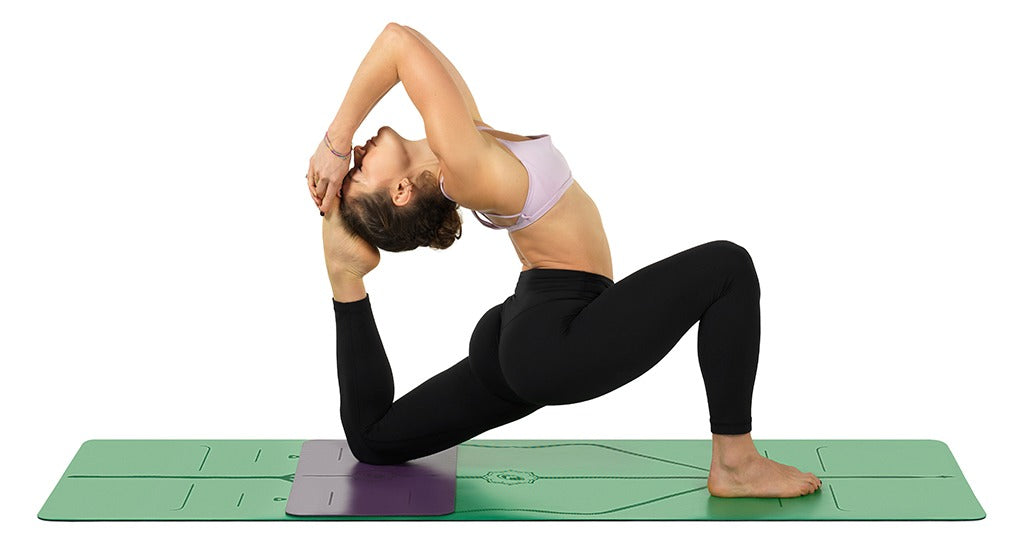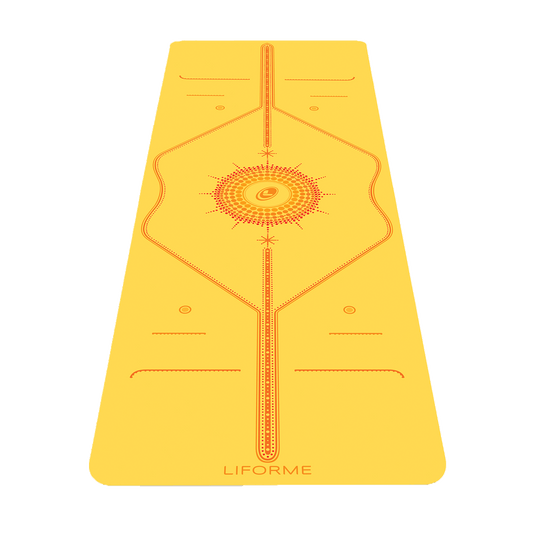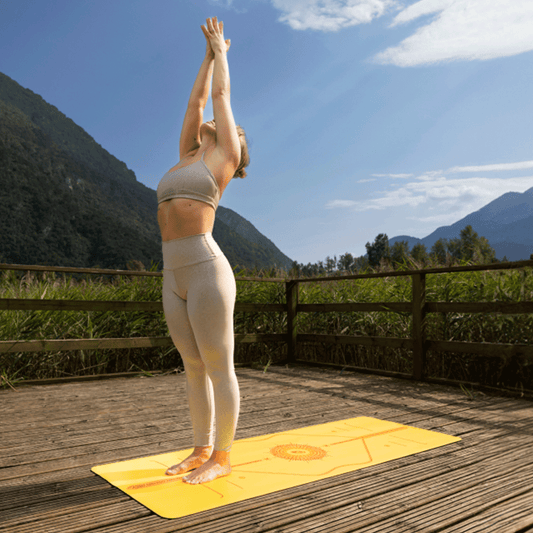Anjaneyasana is a tricky pose to pin down. It goes by more than a few names (Ashva Sanchalanasana or Equestrian Pose, for example), has just as many variations, and can be approached in several ways in terms of alignment and muscular engagement. There’s no one right way to do this pose so we’re going to talk about the possible methods and their effects.
Let’s call the two basic approaches passive versus active. The passive version relies on gravity and the stability of the grounded back knee to allow for a really deep stretch to the hip flexors, groins and quads. In this version, the front knee often comes well past the front ankle and the back thigh approaches the floor.
While this kind of deep stretch can feel good, there is a risk of overdoing it, which can lead to instability and pain around the hip joints and low back, especially as the effects accumulate over time. For that reason, we recommend engaging the muscles that you are stretching, which takes the stretch from passive to active as you create some resistance to gravity. This action may mean that both the front shin and the back thigh stay more perpendicular to the floor so the pose doesn’t look as deep, but it makes for a safer and more effective long-term practice strategy.
The crescent that gives this pose its name comes from the shape made when you take the upper body into spinal extension (also known as a backbend). The degree of back-bending is also a matter of preference and will be affected by the approach you take to the lower body. If you go deep into the front knee, it brings the pelvis into an anterior tilt, which naturally accentuates the lumbar curve of the spine. If you take the more upright version, the pelvis stays more neutral and spinal extension in the lower back is, therefore, less intense. However, this gives you the opportunity to isolate the extension in the upper spine more effectively.
Benefits of Anjaneyasana
• Stretches and strengthens the groins
• Stretches and strengthens the hip flexors
• Stretches and strengthens the quadriceps
• Opens the chest
• Improves core strength
Instructions
1. From Downward Facing Dog, step your right foot to the inside of your right hand. If your foot doesn’t make it to the front of your mat, use your right hand to help it along.
2. Lower your left knee to the mat. If you find pressure on your knees uncomfortable in kneeling postures, take some extra padding under your left knee here. (A Yoga Pad is ideal for this purpose!)
3. Release the top of your left foot to your mat.
4. Lift your hands from the floor and place them on your hips or on top of your right thigh.
5. Move your hips toward the front of your mat any amount to intensify the stretch along the front of your left hip and thigh. Simultaneously, press strongly down through the top of your left foot and the sole of your right foot to bring tone to the muscles you are stretching. Lightly engage your glutes and quads.
6. Isometrically draw the left and right feet toward one another.
7. On an inhalation, lift your arms out to the sides and up toward the ceiling, taking your gaze up toward your thumbs. You can bring your palms to touch overhead or keep them shoulders’ distance apart.
8. On an exhalation, lift your sternum and extend your spine to come into a backbend.
9. Hold for several breaths before releasing and coming to the other side.
Popular variations

Anjaneyasana with quad stretch
1. Lift your back (left) foot away from the floor.
2. Catch your foot with your left hand and draw your heel toward your left buttock any amount for a quadriceps stretch.
3. Play with engaging the quads more for a little resistance against the pressure from your hand.
4. This would be a great time to use a Yoga Pad because there is quite a bit of downward force on your back knee.
Anjaneyasana with a deep backbend
1. From the quad stretch above, let your hips come forward as much as possible to facilitate the extension of the whole spine.
2. Keeping hold of the left foot with your left hand, reach up and overhead with your right hand while extending the spine and the top of your head toward the back of the mat.
3. If possible, catch hold of your left foot with your right hand as your right elbow points straight up to the ceiling. Let go of the foot with your left hand and bring that arm overhead to flip your grip and hold the left foot with both hands.
4. Release the crown of your head toward the sole of your left foot.
Revolved Low Crescent Lunge (Parivrtta Anjaneyasana)
1. Come back to the original pose with your right leg forward.
2. Bring your hands to Anjali mudra at your sternum.
3. On an inhalation, lift your left elbow and trace a big circle with it as you rotate your torso to the right. Complete the circle on your exhalation by hooking your left elbow to the outside of your right knee.
4. Use the traction between your elbow and knee to deepen your twist.
Parivrtta Anjaneyasana with quad stretch
1. From Parivrtta Anjaneyasana, release Anjali mudra and lift your torso to place your left hand on the outside of your right knee.
2. Bend your left knee and lift your left heel toward your left buttock.
3. Reach back with your right hand to grab the outside of your left foot.
4. Lift your left arm toward the ceiling.
Anjaneyasana clearly lends itself to the exploration of rotating and backbending variations so be creative and find your unique expression.
Love,
Liv x





































